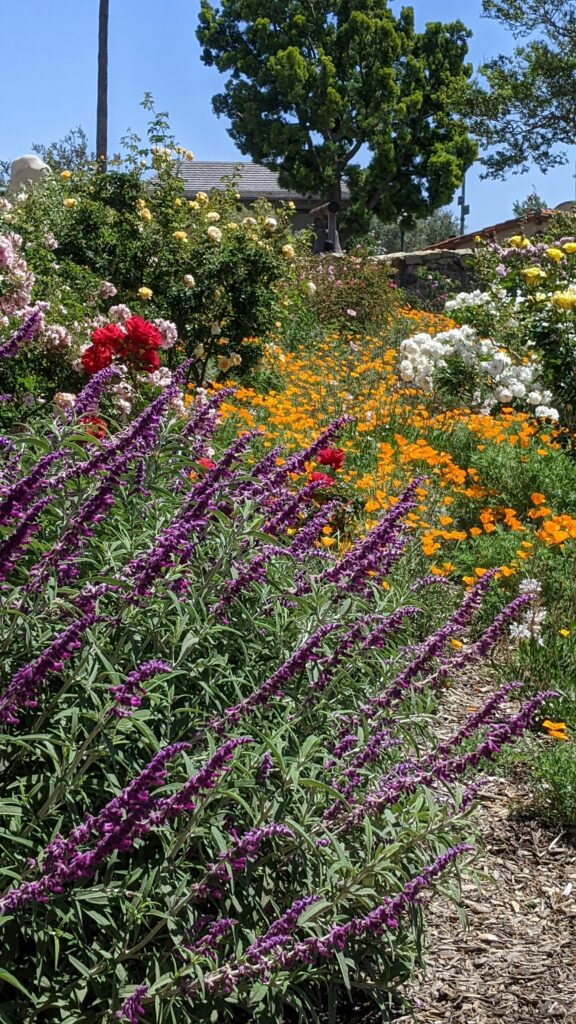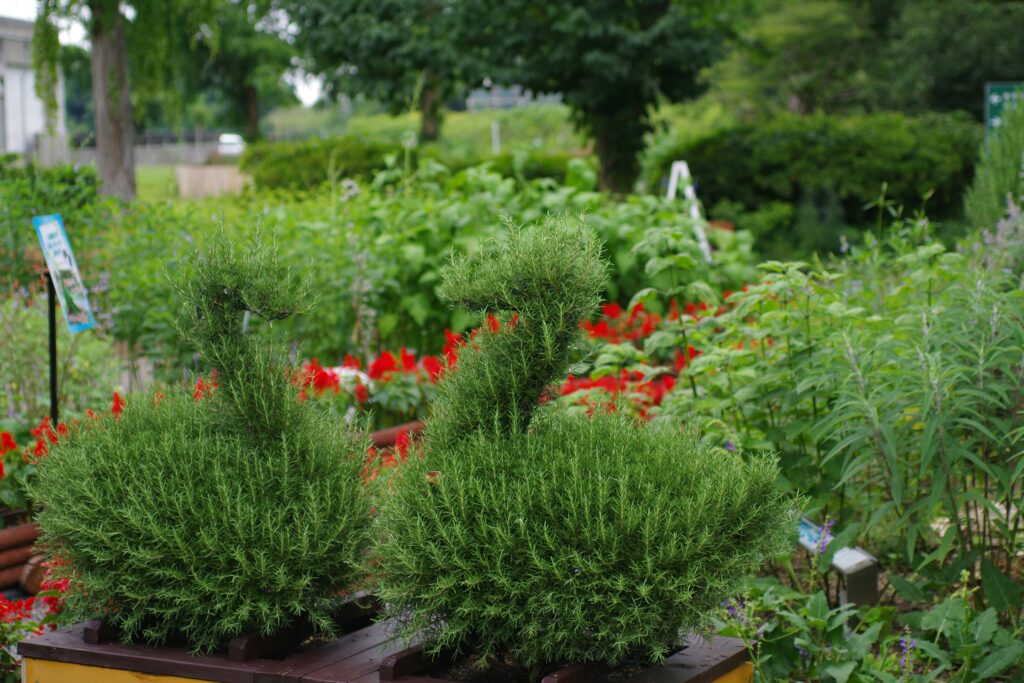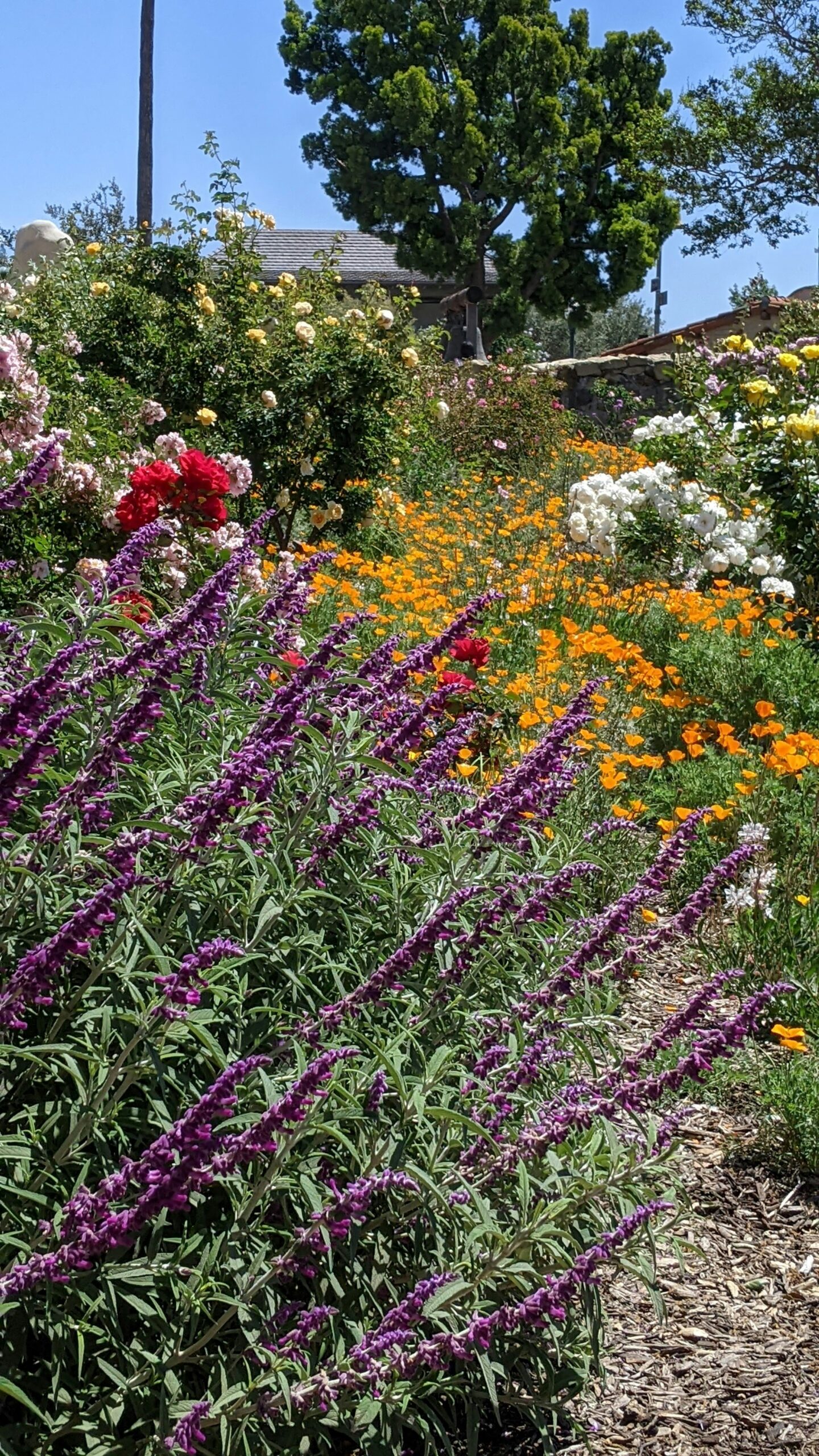Anúncios
Explore how you can grow, eat, and attract with herbs, salads, and pollinators right in your own backyard. This post will delve into the art and science of creating thriving container gardens that serve a dual purpose – providing healthy, homegrown food for your family and attracting beneficial insects and birds. 🌿🥗🐝

Whether you have acres of land or just a tiny balcony, container gardens can transform your space into a lush, edible oasis. Beyond the joy of watching your plants grow and harvesting your own food, you’ll also learn about the vital role pollinators play in our ecosystems. This guide will provide step-by-step instructions on how to create your themed container gardens, from choosing the right plants and containers to maintaining your garden for sustained success.🌱🍅
Anúncios
What makes this guide special is the emphasis on themed gardens. From the spice lovers’ herb garden to the salad enthusiasts’ green leafy paradise, each theme is meticulously curated for your unique needs and preferences. Not only will you have a beautiful and productive container garden, but you’ll also be contributing to the conservation of our pollinators – the unseen heroes of our food system. 🐦🦋
So, whether you’re a seasoned gardener looking for new inspiration or a complete beginner interested in green thumb pursuits, this guide on themed container gardens promises to be both engaging and enlightening. Get ready to embark on a rewarding journey towards sustainable living, food independence, and the joy of gardening. 🏡🍃
Anúncios
Planning Your Themed Container Garden
Embarking on the creation of a beautifully curated container garden begins long before you arrange pots on your patio—it starts with thoughtful, detailed planning. First, take a close look at the environment where you intend to place your containers. Observe the path of the sun throughout the day: does your space bask in direct sunlight for six or more hours (full sun), enjoy a mix of sun and shade (partial sun/partial shade), or remain predominantly shaded? Understanding this will help you pair each plant’s light requirements with its ideal spot, preventing frustration down the line when a sun-loving herb wilts in a shady corner or a shade-tolerant flower scorches under relentless rays.
Beyond light, evaluate other environmental factors: how exposed is the area to wind? Does water tend to pool after rain, or does the soil dry out rapidly between waterings? These nuances affect not only plant selection but also container placement—perhaps heavier, more wind-resistant containers belong along the perimeter, while delicate blooms nestle in sheltered nooks.
Next, turn your attention to the containers themselves. Size matters: deeper and wider vessels supply ample room for roots to spread, reducing overcrowding and nutrient competition. A large container typically holds more potting mix, which stabilizes moisture levels and reduces the frequency of watering. Conversely, smaller pots heat up and dry out more quickly, making them better suited for drought-tolerant succulents or herbs that thrive under drier conditions.
Container material also plays a vital role in plant health and maintenance. Porous terracotta allows excess moisture to evaporate, which can benefit plants prone to root rot but demands more frequent watering. Plastic containers retain moisture longer and are lightweight—ideal for balconies or rooftop gardens—but can degrade more quickly under prolonged UV exposure. Wooden planters offer natural insulation and a classic aesthetic, though they may require sealing to prevent rot, while metal containers bring a modern flair but can heat soil rapidly unless lined or painted with a reflective finish. Weigh material costs, longevity, and care requirements against your budget and aesthetic preferences to make the best choice.
Finally, think about drainage. Ensure every container has drainage holes to prevent waterlogging. If yours don’t, drill or augment drainage, then elevate pots slightly off the ground with feet or pot-saver pads to encourage excess water to escape. Layer a breathable landscape fabric or a thin layer of gravel at the bottom before adding potting mix to prevent soil from seeping out and blocking holes over time.
Choosing Your Theme
Your garden’s theme serves as its unifying thread, guiding plant selection, color palette, and overall styling. An herb container garden brings fragrant foliage and fresh flavors within arm’s reach. Consider planting upright basil varieties for pesto-making, sprawling thyme for groundcover between stones, and woody-stemmed rosemary that doubles as a fragrant miniature shrub. Pair herbs with complementary companions—marigolds can help deter pests, while sweet alyssum attracts beneficial insects.
For a salad-inspired theme, prioritize crisp textures and vibrant hues. Mix loose-leaf lettuce in shades of green and red, peppery arugula, spinach for a mild, silky bite, and radishes that add pops of scarlet and zesty crunch. Interplant edible flowers like nasturtiums or violas for a visual treat and peppery nuance, and tuck in pots of chives or green onions to add a mild Allium accent.
If your goal is to transform your container display into a pollinator haven, choose an array of nectar-rich, bright-colored blossoms that bloom in succession. Early-season lavender and catmint provide spring nectar, followed by midsummer marigolds, zinnias, and cosmos in fiery reds and oranges. Late-season asters, salvias, and goldenrods will extend your garden’s appeal into autumn, offering sustenance for migrating butterflies and bees preparing for cooler weather. To ensure continuous bloom, plan overlapping flowering times and deadhead spent blooms regularly to encourage new ones.
You might also opt for more specialized themes—a “culinary cocktail” garden featuring citrus-scented mint for mojitos, lemongrass for tropical-inspired beverages, and edible flowers like borage; or a “sensory sanctuary” with soft lamb’s ear for touch, fragrant gardenias for scent, and vibrant begonias for color. Whatever avenue you choose, sketch out a rough design on paper or using a digital tool, arranging container sizes, heights, and textures to achieve visual balance. Incorporate decorative elements—such as plant markers, trellises for climbing vines, and grouping pots of varied heights—to complete your theme and ensure an engaging, dynamic display.
Creating a Herb Container Garden
Herbs are exceptionally well suited for container gardening thanks to their compact growth habits, minimal space requirements, and high culinary value. Beyond elevating the flavor profiles of your favorite dishes, herbs also fill your outdoor space with delightful fragrances, add lush greenery, and create an attractive focal point on a balcony, patio, or windowsill. With the right planning and care, a small collection of containers can yield months of fresh herbs, saving trips to the grocery store while providing a continuous harvest of vibrant, nutrient-rich leaves.
Selecting Your Herb Varieties
Begin by choosing herbs that align with your cooking habits and flavor preferences. Popular and versatile options include:
- Basil: Choose from classic Genovese for pesto and salads, purple basil for visual interest, or lemon basil for a citrusy twist.
- Parsley: Flat-leaf (Italian) parsley offers robust flavor, while curly parsley provides decorative fronds ideal for garnishing.
- Rosemary: Its woody stems and pine-like aroma make it perfect for roasting meats, infusing oils, and adding structure to mixed planters.
- Thyme: A low-growing perennial with tiny leaves and delicate sprigs, thyme pairs beautifully with roasted vegetables, stews, and breads.
- Oregano: With both Mediterranean and Greek varieties available, oregano’s bold, peppery taste suits tomato sauces, grilled vegetables, and pizzas.
- Mint: Choose from spearmint for mojitos, peppermint for a cooling note in teas, or chocolate mint for a sweet accent. Mint spreads vigorously—plant alone or in a deep, narrow pot to contain its roots.
Feel free to expand your palette with cilantro for salsa and curries, chives for mild onion flavor, or dill for pickles and seafood dishes. When selecting young plants (transplants) or seeds, look for healthy foliage and avoid any specimens showing signs of yellowing, wilting, or pest damage.
Potting Mix, Containers, and Placement
Use a high-quality, soilless potting mix formulated for containerized plants rather than garden soil. These mixes balance moisture retention and drainage, often incorporating ingredients like peat moss, coconut coir, perlite, and composted bark. Fill containers to within an inch of the rim, leaving room for watering without overflow.
Opt for containers with ample drainage holes. Standard terracotta pots offer breathability but dry out more quickly, whereas plastic or glazed ceramic retain moisture longer. For a self-contained watering solution, consider self-watering planters with built-in reservoirs, which reduce watering frequency by wicking moisture upward as needed.
Position your herb containers where they will receive at least 6–8 hours of bright, direct sunlight each day. If indoor light is insufficient, supplement with a full-spectrum LED grow light positioned 12–18 inches above the plants for 10–12 hours daily. Rotate pots weekly to ensure even growth and prevent herbs from leaning toward the light source.
Watering, Feeding, and Maintenance
Herbs in containers often require more frequent watering than those in the ground because potting mix dries out faster. Check moisture levels by inserting your finger an inch into the soil—if it feels dry at that depth, it’s time to water. Water thoroughly until you see excess draining from the bottom, then allow the soil surface to dry slightly before watering again.
Feed your herbs with a balanced, water-soluble fertilizer every 3–4 weeks during the growing season. Alternatively, enrich the potting mix at planting time with slow-release organic granules. Avoid overfertilizing, which can lead to excessive leaf growth at the expense of essential oils and flavor development.
Prune herbs regularly to encourage bushier growth and prevent legginess. Snip just above a set of leaves, harvesting no more than one-third of the plant at a time. Remove any yellowing or drooping foliage promptly to promote air circulation and reduce disease risk.
Harvesting Tips for Maximum Yield
Frequent, light harvesting stimulates new leaf production. For basil, pinch off the flowering tops as soon as buds appear to keep energy focused on foliage. For mint and parsley, harvest outer stems first, allowing inner shoots to mature. Store harvested herbs by misting lightly and wrapping loosely in a damp paper towel inside a plastic bag—then refrigerate for up to a week. Freeze excess leaves in ice cube trays with olive oil or water for long-term storage.
Common Challenges and Solutions
- Rapid Drying: In hot, windy conditions, container soil can dry out within hours. Mitigate this by grouping containers together to create a micro-climate, adding a layer of mulch (such as decorative pebbles or bark chips) on the soil surface, or installing a drip irrigation line with emitters set on a timer.
- Root Bound Plants: Over time, herbs may outgrow their pots, leading to stunted growth. Repot into larger containers or divide perennials like mint and thyme every couple of years to refresh root systems.
- Pests and Diseases: Aphids, spider mites, and whiteflies can appear on container herbs. Introduce beneficial insects (ladybugs), spray with insecticidal soap, or rinse foliage with a strong stream of water weekly. Prevent fungal diseases by ensuring good air circulation, avoiding overhead watering, and removing debris from soil surfaces.
- Nutrient Depletion: Nutrients leach from container soil more quickly than garden beds. Conduct a simple soil test mid-season; if deficiencies appear (yellowing leaves, slowed growth), apply a foliar feed or side-dress with compost tea.
By selecting the right herbs, providing quality soil and adequate light, and staying vigilant about watering and maintenance, your herb container garden will flourish. Not only will you enjoy fresh, homegrown flavors year-round, but you’ll also delight in the therapeutic ritual of tending to your own personal kitchen garden.
Designing a Salad Container Garden
A salad container garden is a great way to grow your own fresh, nutritious greens. Similar to an herb garden, a salad garden requires careful planning and regular maintenance to thrive.
Begin by selecting a variety of salad greens that grow well in containers. Some options include:
- Lettuce
- Spinach
- Arugula
- Kale
- Swiss chard
Once your greens are planted, remember to provide them with plenty of sunlight and water. Harvest your greens regularly to encourage new growth and to ensure a continuous supply of fresh salad ingredients.
Maximizing Your Harvest
To maximize your harvest, consider using a technique known as succession planting. This involves planting new seeds every two weeks to ensure a continuous harvest throughout the growing season.
Another technique is to grow plants with different maturity dates. This means you’ll have some plants ready to harvest early in the season, while others will be ready later on, extending your harvest period.
Attracting Pollinators with Container Gardens
Pollinators play a critical role in the health and productivity of any garden. They transfer pollen from the male parts of a flower to the female parts, enabling fertilization and the production of fruits and seeds.
To attract pollinators to your container garden, consider growing plants with bright, fragrant flowers. Some popular choices include:
- Marigolds
- Zinnias
- Lavender
- Sunflowers
- Bee balm
Supporting Pollinator Health
In addition to providing food sources for pollinators, it’s also important to create a safe and welcoming environment for them. Avoid the use of pesticides, which can harm pollinators, and provide a water source for them to drink from.
Furthermore, if possible, leave some of your garden plants to overwinter, as some pollinators use dead plant material for shelter during the colder months. By supporting pollinator health, you’re not only enhancing your garden’s productivity, but also contributing to global biodiversity and ecosystem health.

Conclusion
In conclusion, “Grow, Eat, and Attract with Themed Container Gardens: A Guide to Herbs, Salads, and Pollinators in Your Own Backyard” offers an enriching, rewarding experience that brings the magic of nature right to your doorstep. This guide not only presents an opportunity to cultivate a healthier lifestyle through homegrown herbs and salads but also encourages the presence of pollinators, enhancing the ecosystem’s vitality. Container gardening is a versatile, accessible practice that caters to both experienced gardeners and novices, making green thumbs of us all.
The notion of themed gardens adds a unique touch, creating an engaging environment that can be a source of relaxation and joy. Moreover, it promotes sustainable living, contributing positively towards our planet’s well-being. This is a beautiful blend of aesthetics, utility, and environmental stewardship.
Embrace the pleasures of gardening and enjoy the fruits of your labor, literally and figuratively. Whether it’s the fresh flavor of homegrown salads, the aromatic charm of various herbs, or the delightful sight of visiting pollinators, container gardens offer a cornucopia of wonders. This journey of growth, consumption, and attraction in your own backyard is a testament to the saying – the best things in life are often the simplest. Let’s go green, grow green, and eat green, one container at a time!

